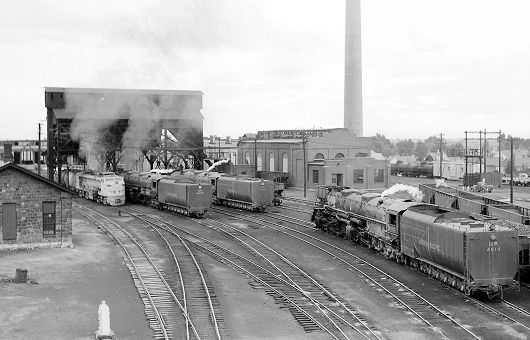|
|

This web site presents images of the Union Pacific Railroad's General Electric gas turbine-electric locomotives that were in service at Laramie, Wyoming in August 1957. At that time locomotives of both the first- and second-generation turbine models were operating. Eventually they were supplanted by the third-generation model, of which we have one photo taken at the Illinois Railway Museum in 2008. 
In this photo of the Laramie terminal taken by David V. Leonard on August 15, 1957, A 1950 Westinghouse 4000-horsepower gas turbine demonstrator was tested on several railroads in both passenger and freight service, but had no buyers. In 1949, however, the Union Pacific had already placed in service as its No. 50 (though the UP never actually owned it), a 4500-horsepower double-cabbed demonstrator built by General Electric in 1948 in cooperation with the American Locomotive Company. It had four two-axle trucks. Ten more units, Nos. 51-60, were delivered to Union Pacific beginning in 1952; they had the same wheel arrangement as No. 50 (which was returned to the builders), but had a cab at only one end. Beginning in 1954, GE delivered the second-generation units, Nos. 61-75. These differed from the earlier group in having a recessed walkway along the side; hence they were popularly styled "verandas." The third generation of gas turbines, Nos. 1-30, were delivered from 1958-1961. These 8500-horsepower locomotives were in two units, each having two three-axle trucks; the turbine prime mover was located in the second unit, while the first unit carried the diesel generator. The turbine locomotives were heavy haulers, but noisy; their high-pitched whine caused them to be dubbed the "Big Blows," and their use was restricted to the open Western plains. Their prime movers powered electric generators supplying current to the traction motors in the trucks. They also had auxiliary diesel generators for power when starting, or for yard movements when the turbines were shut down. In 1955 the turbines began to be equipped with tenders from retired steam locomotives to augment their supply of fuel and increase their range. Their original fuel oil, a by-product of the refining process, was called Bunker C; a different type of heavy oil was later introduced. This oil was cheaper than other types, but more of it was required to produce the same power output. Moreover, it was corrosive on the turbine blades, leading to the early retirement of the gas turbine-electric units. By 1970 the last group had been displaced by diesel power. Several of the photos in this collection were taken by my brother, the late David V. Leonard, while the rest are my own work. Click on the thumbnails below to view the full-size image. You can also page through the collection sequentially. Dr. Richard Leonard |
|













